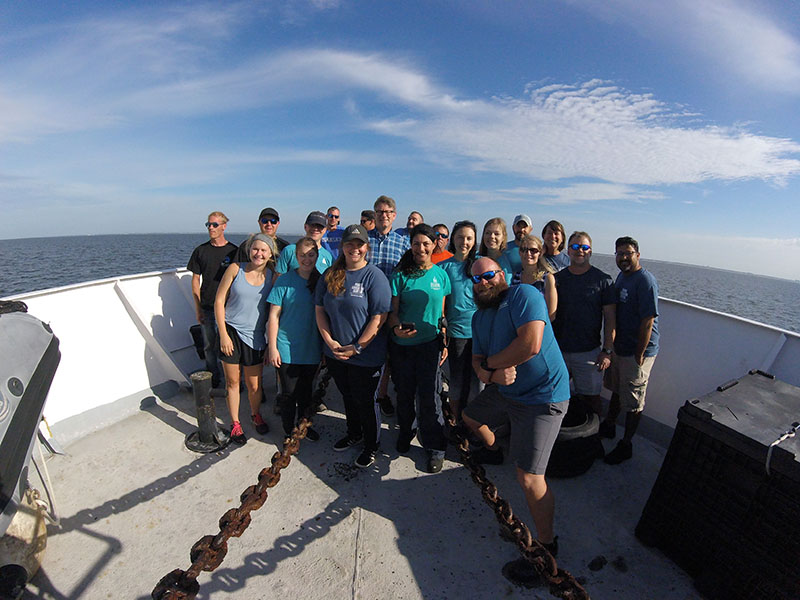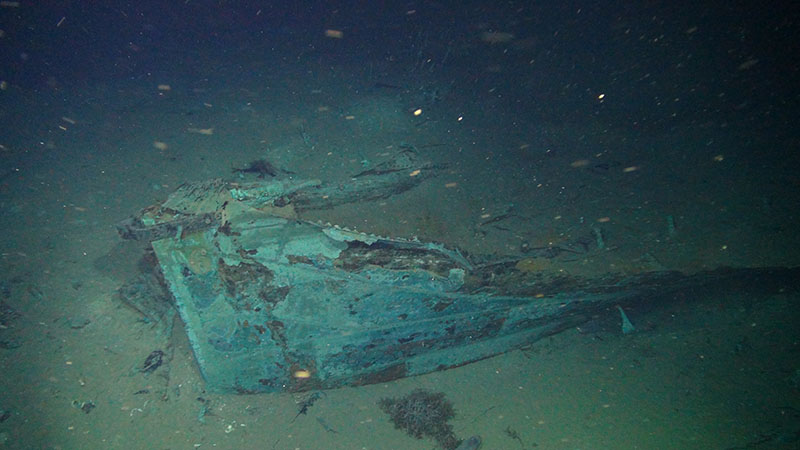
By Dr. Leila Hamdan, Chief Scientist
July 3, 2019

Scientific party and crew aboard R/V Point Sur. Image courtesy of Microbial Stowaways. Download larger version (jpg, 3.5 MB).
During the lead up to, and execution of an at-sea expedition, it is often easy for me to get caught up in the details, such that I miss the larger view of what we have done. I have been affectionately calling a major element of this research trip my “Gigantic, Terrifying Experiment”, or GTE. The GTE, to put it simply, is ambitions—a technical tool to study how microbes disperse across the seafloor from shipwreck to shipwreck involving weights, floats, line, and instrumentation. This idea of dispersal has intrigued me for a number of years, and this expedition was our first attempt to scientifically study the concept. The GTE is large, as far as microbiome experiments go, with a 200 lb lander, 200 lb experimental array, and an added 200 lb of expendable weights. Lowering it to the seafloor on the remotely operated vehicle (ROV) tether, and then draping it gently across the seabed took skill, a competent team, and nerves of steel. With nearly a quarter mile of line, the chance for entanglement with the ROV was a daily reality on this cruise (hence the ‘terrifying’ part), but we met that reality with knowledge, planning, and teamwork. When everyone is working together on the ship, we call it a dance, and by the last deployment of the GTE, we were truly dancing in the dark. The big picture is that we gridded out eight precision push coring transects around the historic shipwrecks we discovered and laid down over a mile of experiments on the seafloor. From here, the discoveries we make are only limited by our imagination. Ambition takes one person; execution takes a team. As the Chief Scientist of this expedition, I view that teamwork as our greatest accomplishment.
We also discovered TWO historic shipwrecks. Prior to embarking, both were ambiguous sonar targets. We now know them to be copper sheathed wooden sailing vessels likely dating to the latter 19th century. One of our previous logs described Site 15711—a small shipwreck at approximately 500 meters (~1,640 feet) deep, containing many artifacts, including the ship’s bell.

The stern of the shipwreck at Site 15470 captured by ROV Odysseus. Image captured by ROV Odysseus, courtesy of Microbial Stowaways. Download larger version (jpg, 9.5 MB).
The second one, Site 15470, however has a special place in my scientific mind. We discovered Site 15470 in 5,700 feet of water—greater than one mile deep in the Mississippi Canyon lease area. Prior to our expedition, the site was simply known as an ‘ambiguous sonar target’—we now know it is among the deepest shipwrecks discovered in the Gulf of Mexico. The shipwreck was approximately the same size as our research vessel Point Sur at ~100 feet long. Seeing it for the first time was breathtaking. It struck me as a quiet, reverent place, with water clarity unlike any other shipwreck I have visited. That clarity allowed the teal copper sheathing of the wreck to stand out against the grey/olive loveliness of the seabed. The shipwreck had dark colored glass bottles in the area—likely the ship’s stores, ornate blue and pink plates, a bright, shiny spoon sitting atop a layer of marine sediment, and the ship’s spyglass, a long tube of green copper, with the glass at the end reflecting in the ROV’s bright light.
We don’t know yet what the ships found at Sites 15711 and 15470 were doing in the past “blue” economy. They may have been fishing or cargo vessels. They were likely underway either to or from the U.S. Gulf Coast. The shipwrecks contain stories of the past, a reflection of our history in the maritime environment, and now, contemporary life in the deep sea, both macro and microbiological.
And that is where our exploration goes from this point forward. The work to describe these historic discoveries is underway with our team of archaeologists. We also begin our work to address a pressing and contemporary need for information on how these shipwrecks impact invisible life in the deep sea. Microbes are the earliest, most sensitive biological detectors of change in the ocean. Through the innovation of our diverse group of scientists, the expertise of our ROV team, and the skill of R/V Point Sur’s crew, we can ask for the first time how shipwrecks shape microbial diversity in the deep ocean.
I look back at the work we did during the past nine days with great pride, and look forward with anticipation towards what we still have to learn. We worked as one unified team, supporting each other’s work, solving problems together, and making progress in understanding remote areas of the ocean.
“You can’t start a fire without a spark, this gun is for hire, even if we are just dancing in the dark”
–Bruce Springsteen